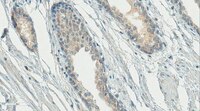MAB5456-C Sigma-AldrichAnti-Gonadotropin-Releasing Hormone Antibody, NT, clone HU11B (Ascites Free)
Anti-Gonadotropin-Releasing Hormone Antibody, NT, clone HU11B (Ascites Free) is an antibody against Gonadotropin-Releasing Hormone for use in Immunohistochemistry (Paraffin), Affinity Binding Assay, Immunofluorescence, Electron Microscopy.
More>> Anti-Gonadotropin-Releasing Hormone Antibody, NT, clone HU11B (Ascites Free) is an antibody against Gonadotropin-Releasing Hormone for use in Immunohistochemistry (Paraffin), Affinity Binding Assay, Immunofluorescence, Electron Microscopy. Less<<Recommended Products
Overview
| Replacement Information |
|---|
Key Spec Table
| Species Reactivity | Key Applications | Host | Format | Antibody Type |
|---|---|---|---|---|
| H, R, M, Rhesus Macaque | IH(P), ABA, IF, EM | M | Purified | Monoclonal Antibody |
| References |
|---|
| Product Information | |
|---|---|
| Format | Purified |
| Presentation | Purified mouse monoclonal IgG1κ antibody in buffer containing 0.1 M Tris-Glycine (pH 7.4), 150 mM NaCl with 0.05% sodium azide. |
| Quality Level | MQ100 |
| Physicochemical Information |
|---|
| Dimensions |
|---|
| Materials Information |
|---|
| Toxicological Information |
|---|
| Safety Information according to GHS |
|---|
| Safety Information |
|---|
| Storage and Shipping Information | |
|---|---|
| Storage Conditions | Stable for 1 year at 2-8°C from date of receipt. |
| Packaging Information | |
|---|---|
| Material Size | 100 μg |
| Transport Information |
|---|
| Supplemental Information |
|---|
| Specifications |
|---|
| Global Trade Item Number | |
|---|---|
| Catalogue Number | GTIN |
| MAB5456-C | 04055977312409 |
Documentation
Anti-Gonadotropin-Releasing Hormone Antibody, NT, clone HU11B (Ascites Free) SDS
| Title |
|---|
Anti-Gonadotropin-Releasing Hormone Antibody, NT, clone HU11B (Ascites Free) Certificates of Analysis
Brochure
| Title |
|---|
| Neuroscience Solutions for productive research |








